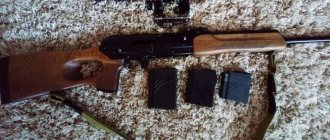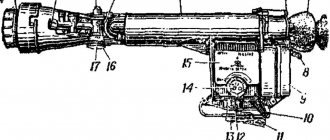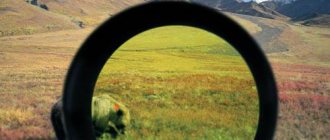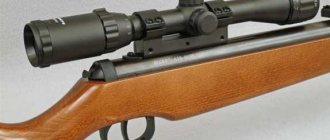Driven hunting is one of the oldest and most widespread types of hunting, and the variety of optical instruments raises a large number of questions that arise when choosing.
There are three main types of driven hunting:
- rush (many shooters and one beater);
- corral (many shooters and many beaters);
- roundup (hunting is carried out simultaneously for several types of game).
The second type of hunting is carried out only during the day, as it can pose a danger to hunters, which is reflected in the laws. Even in dense falling snow or fog, experienced beaters will not participate in a driven hunt. Therefore, in this situation, you should not consider optical sights for hunting with large lenses designed for high aperture.
Driven hunt
This is one of the oldest types of hunting for ungulates. It is organized and led, as a rule, by experienced huntsmen who know the area and the game living on it very well. The leader is responsible for the safety of all participants; the results largely depend on his skills. Hunting is carried out only during daylight hours; each beater must be clearly visible from afar; for this purpose, the equipment is usually supplemented with bright vests.
Hunters are divided into two groups: beaters and shooters. Ideally, the role of beaters is played by experienced huntsmen, but there are not always enough of them. The beaters are also divided into two groups. The first drives the animal directly towards the shooters, the second is located on the flanks of the first group to prevent the elk or wild boar from leaving the frame.
The shooters form a shooting line and wait for prey in strictly designated places (numbers), knowing their firing sector in advance. The distance between hunters is usually 80-100 meters and depends on the type of weapon and its range. Hunters are prohibited from shooting without a signal given by the hunt leader. They are also strictly forbidden to leave their room, shoot in the direction of neighbors, or hit an animal that is in someone else’s sector.
Requirements for sights and their types
Undoubtedly, the hunter’s results depend most on his experience, skill and luck, but a high-quality and well-chosen optical sight for driven hunting can be an excellent help, and sometimes the decisive factor for a well-aimed shot. The correct choice of a scope is determined by the conditions in which the hunt takes place: shooting is carried out during the day at a distance of 50-100 meters, the animal moves quickly, in addition, you have to get to the shooting line on foot, so the dimensions and weight of the weapon are important.
Since shooting is during the day, there is no need for thermal imaging scopes for hunting. They are useful at night, but driving ungulates is prohibited even in light twilight. The intimidated animal, wanting to save its life, runs very quickly, the hunter has little time to properly aim. Therefore, optical sights with high magnification are hardly suitable for driven hunting. They are great for shooting at long distances and at a slow-moving target, but it is very difficult to catch a rushing elk or wild boar with such a scope.
Collimator sights without magnification
Collimator sights first appeared in aviation about half a century ago; they are used by hunters relatively recently, but are already quite competitive with optical sights and thermal imaging sights for hunting. Collimator sights are:
- active (with battery) and passive (without power);
- closed type, structurally made like their optical counterparts, and open type with one lens;
- holographic or laser mark of the sight.
But all varieties have the same principle of operation: the light flux (parallel rays) directed at the target is projected onto the lens. The hunter just needs to align the mark with the target and shoot. Moreover, collimator sights allow you to aim with both eyes, while simultaneously seeing the animal in the aiming reticle and the surrounding landscape. Even after the recoil from the shot, the collimator’s aiming line does not go astray, the hunter is in complete control of the situation, this is especially important when shooting at fast-moving targets.
Night devices with image intensifier tubes I and I+ generations
Products with first generation image intensifier tubes are relatively inexpensive. Such devices include, for example, hunting rifles. In addition, first-generation night devices are designed for shooting at a target from a short distance (up to 80-150 m). They are characterized by the following features:
- the presence of clarity in the image exclusively in the center;
- distortion of the image at the edges;
- presence of small resolution.
A striking example of such products is the Daedalus 180 HR (100) night vision sight. This model is equipped with a durable metal-ceramic body and is perfect for working with smooth-bore guns.
One of the advantages of this class is its affordable price. The downsides are sensitivity to flare and limited additional options.
Generation I+ equipment has greater resolution. It is considered more powerful and has reliable fiber optic washers that are located at the input and output of the device. And although such models, as a rule, have a higher price than the first generation image intensifier tubes, they are equipped with special protection against flare. For example, such devices include the Pulsar (night vision scope).
Red dot sights with magnification
To increase the capabilities of the sight, collimators are sometimes equipped with either their own magnifying lens or an additional removable magnifying attachment. Such a tandem can significantly expand the functionality of the sight: increase the accuracy of shots at long distances, while maintaining the advantages of a collimator.
However, it should be taken into account that in driven hunting, the speed of aiming and shooting comes first. Therefore, the mounting of the optical sight should allow it to be quickly removed in order to use a red dot sight, which is more preferable when shooting at short distances.
Advantages and disadvantages of collimator sights
Advantages:
- Aiming with two eyes.
- Compact and light weight, especially for open sights.
- Simplicity and ease of use. The collimator is an excellent assistant for beginners, because it greatly simplifies aiming and compensates for the lack of skill, and also allows you to accurately shoot offhand and from awkward positions.
- An excellent combination of aiming speed and shot accuracy.
- Durability. Provided that it is not a dubious Asian fake. Experienced hunters and experts advise purchasing high-quality, proven devices from well-known manufacturers. These include , Hakko, Aimpoint, Leapers, Sightmark, Leapers.
Flaws:
- Inaccuracy appears when shooting at long distances because the collimator aims parallel light beams at the target and does not take into account the downward ballistic trajectory of the charge. However, this drawback is hardly noticeable during driven hunting, where the animal is shot from 50-100 meters.
- Energy dependence. Active collimators are powered by batteries, which, according to the law of meanness, tend to “sit down” at the most inappropriate moment. But an attentive hunter will not allow this to happen; he will turn off the power when the scope is inactive, and take a spare set of batteries with him.
- Lens contamination. Snow, drops of water, dust, and various debris falling on the lens interfere with the hunter. However, they are easy to remove; in addition, the manufacturer often provides special caps and visors to protect the lenses.
Optical sights for driven hunting with single magnification
Essentially, these sights work like collimators, helping the hunter quickly and accurately target game. Single magnification allows you to perceive the image equally with both eyes. The eye looking through the eyepiece sees a reticle superimposed on the target, while the other eye sees the entire area. Both images are easily and without distortion combined into one. The hunter has excellent control over the situation without losing sight of the animal, as often happens when using magnified sights.
In addition, single power scopes are cheaper and smaller in size than variable power scopes. Lightness and compactness become important characteristics in driven hunting, where shooters sometimes have to travel considerable distances to their numbers.
Optionality
If you work equally successfully with both the front sight and the whole thing, and with optics, then you should pay attention to the presence of quick-release mounts on the latter. Although they are noticeably more expensive than options with “eternal” installation, they greatly facilitate the fishing process.
As additional options, many experienced beaters recommend devices with illuminated reticle. Although hunting takes place during the day, such assistance will not hurt people with impaired vision and will also make hunting easier.
Optical sights with variable magnification
Fans of more functional optics sometimes prefer to equip their weapons with sights that can change the magnification. This way they can, if necessary, increase accuracy when shooting at targets located further than a hundred meters. However, during driven hunting there is no need for devices with a magnification greater than x4. High magnification significantly narrows the shooter’s field of vision, making it very difficult for him to catch moving game in his sights.
To illustrate: a scope with a single magnification at 100 meters provides a view of 42 meters wide, and a six-fold magnification narrows the view to just 7 meters. It is very difficult to catch and hold a fast-running wild boar or even a huge elk, which means that the probability of a hit is significantly reduced.
On what principle does the device work in the dark?
The operating principle of a night vision device, or NVG for short, is to capture light reflected from an object and magnify it many times over. In this case, the light source can be a lamppost, a fluorescent lamp, the starry sky or the full moon.
The process of operation of the device is as follows: the light reflected from the light source is transmitted to the sight lens, and then immediately redirected to the converter (IIT); at the next stage, the light received by the device is multiplied and transmitted to the observer’s eye.
Ultimately, the light signal transmitted to the night vision scope is processed in a certain sense and takes on a monochrome appearance. As a rule, the observer sees the resulting image in green tones.
If a person with a night vision device is forced to work in conditions of complete absence of light, then he can always use the infrared lamp built into the device. Let us recall that such lamps produce light that is recognizable by the eye of the observer in the long-wave range.
Advantages and disadvantages of optics
Advantages:
- The single shot sight has the advantages of a passive closed red dot sight. Allows you to quickly aim with both eyes.
- An optical sight helps you better focus on your target.
Flaws:
- Optics significantly make the weapon heavier, changing its balance and dimensions, which complicates shooting and movement through the forest.
- When using an optical sight, the hunter must constantly ensure that his line of vision coincides with the axis of the sight.
- Magnifying sights reduce the likelihood of a hit during a driven hunt, make it difficult to aim, and negate the ability to see the target equally with both eyes.
What types of night vision devices are there?
If you are just planning to purchase a night vision scope, you need to know what types of NVGs there are. In total, these products can be divided into three types:
- instruments used to observe objects in the dark;
- sights for hunting and military weapons;
- night vision goggles.
All of these types of night vision devices (except the first) can be used both as independent products and in combination with weapons. Also on sale are light-amplifying and thermal imaging devices for night vision. Consequently, the choice of device will directly depend on the final purposes of using the equipment and on the distance at which it is planned to come into direct contact with the enemy or surveillance object.
Results
For driven hunting, collimator sights of an open or closed design look preferable for both rifled and smooth-bore weapons. Their advantages over optical sights are obvious:
- Collimator sights allow you to aim offhand, accurately and quickly with both eyes. An optical sight with a magnification of one is a collimator that does not have an illuminated, convenient mark.
- Open type collimators are great for the novice hunter, they increase shooting accuracy and will not hit an inexperienced shooter with recoil.
- These scopes are durable, easy to operate, and generally less expensive than quality rifle scopes. But you shouldn’t buy cheap and unknown red dot sights that can crumble after a few shots. It is better to choose such reliable products as Cobra, Hakko, Aimpoint, Leapers, Sightmark, Leapers sights.
- To increase the capabilities and range of accurate shooting, you can install collimator sights on weapons in tandem with a quick-release magnifying attachment.
Night devices with II and II+ generation image intensifiers
Second-generation devices are considered a kind of golden mean among other devices in the product line. That is why they are most in demand among amateur hunters who have some experience in target shooting. The main advantage of such equipment is that it can be used to perform work even in the complete absence of any lighting.
These devices also have modern high-aperture filters that provide three- and five-fold magnification of the object being studied. In addition, night devices of this generation are able to distinguish a human silhouette in small details from a distance of 250-300 m.
Generation II+ devices have a useful option for increasing the capabilities of light emission. As practice shows, devices of this type have greater sensitivity and high image resolution, so they are often used when working in open areas. For example, similar devices include the Sentinel night vision sight and its models G2+ 3x50, G2+ 3x50 MD and others.




